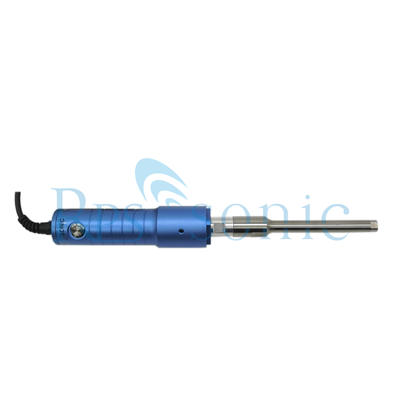
loading












| Availability: | |
|---|---|
| Quantity: | |
| Place of Origin | China |
|---|---|
| Brand Name | RPS-SONIC |
| Certification | CE |
| Model Number | RPS-SONO40-100 |
| Minimum Order Quantity | 1set |
| Packaging Details | carton box |
| Payment Terms | T/T |
| Supply Ability | 200pcs |
40Khz 100W High frequency ultrasonic cell disruption machine, Titanium hom
Parameter:
| Model | SONOL20-300 | SONOL20-500 | SONOL28-300 | SONOL40-100 |
| Frequency | 20±0.5 KHz | 20±0.5 KHz | 28±0.5 KHz | 40±0.5 KHz |
| Power | 300 W | 500 W | 300 W | 100 W |
| Voltage | 220/110V | 220/110V | 220/110V | 220/110V |
| Temperature | 300 ℃ | 300 ℃ | 300 ℃ | 300 ℃ |
| Pressure | 35 MPa | 35 MPa | 35 MPa | 35 MPa |
| Max Capacity | 2 L/Min | 5 L/Min | 1L/Min | 0.5 L/Min |
| Tip Head Material | Titanium Alloy | Titanium Alloy | Titanium Alloy | Titanium Alloy |
An ultrasonic cell disruptor (or ultrasonic homogenizer) is a device used in biological, chemical, and industrial laboratories to break open cells and disrupt their structure using high-frequency sound waves. The process involves creating ultrasonic vibrations that induce cavitation in liquids, leading to mechanical shearing forces that break cells apart and release their contents.
Cavitation: High-frequency sound waves produce microscopic bubbles in the liquid, which rapidly expand and collapse, generating intense pressure and shear forces. These forces disrupt cell membranes and break them open.
The process also causes the release of cellular contents, such as proteins, nucleic acids, or organelles.
Biology and Biochemistry:
Cell lysis for DNA, RNA, or protein extraction.
Homogenizing tissue samples.
Pharmaceuticals:
Preparing emulsions and dispersions.
Particle size reduction.
Nanotechnology:
Dispersing nanoparticles in suspensions.
Breaking down aggregates.
Chemical Synthesis:
Enhancing reactions that benefit from high-energy environments.
Food and Beverage:
Emulsification and mixing.
Ultrasonic Generator: Produces high-frequency electrical energy.
Transducer: Converts electrical energy into mechanical vibrations.
Probe (or Horn): Transfers ultrasonic vibrations into the sample, often made of titanium for durability.
Sample Chamber: Holds the liquid or cell suspension to be treated.
Efficient for small-scale and precise operations.
Rapid and easy to use.
Minimal sample contamination (with proper maintenance).
Compatible with a wide range of sample types.

40Khz 100W High frequency ultrasonic cell disruption machine, Titanium hom
Parameter:
| Model | SONOL20-300 | SONOL20-500 | SONOL28-300 | SONOL40-100 |
| Frequency | 20±0.5 KHz | 20±0.5 KHz | 28±0.5 KHz | 40±0.5 KHz |
| Power | 300 W | 500 W | 300 W | 100 W |
| Voltage | 220/110V | 220/110V | 220/110V | 220/110V |
| Temperature | 300 ℃ | 300 ℃ | 300 ℃ | 300 ℃ |
| Pressure | 35 MPa | 35 MPa | 35 MPa | 35 MPa |
| Max Capacity | 2 L/Min | 5 L/Min | 1L/Min | 0.5 L/Min |
| Tip Head Material | Titanium Alloy | Titanium Alloy | Titanium Alloy | Titanium Alloy |
An ultrasonic cell disruptor (or ultrasonic homogenizer) is a device used in biological, chemical, and industrial laboratories to break open cells and disrupt their structure using high-frequency sound waves. The process involves creating ultrasonic vibrations that induce cavitation in liquids, leading to mechanical shearing forces that break cells apart and release their contents.
Cavitation: High-frequency sound waves produce microscopic bubbles in the liquid, which rapidly expand and collapse, generating intense pressure and shear forces. These forces disrupt cell membranes and break them open.
The process also causes the release of cellular contents, such as proteins, nucleic acids, or organelles.
Biology and Biochemistry:
Cell lysis for DNA, RNA, or protein extraction.
Homogenizing tissue samples.
Pharmaceuticals:
Preparing emulsions and dispersions.
Particle size reduction.
Nanotechnology:
Dispersing nanoparticles in suspensions.
Breaking down aggregates.
Chemical Synthesis:
Enhancing reactions that benefit from high-energy environments.
Food and Beverage:
Emulsification and mixing.
Ultrasonic Generator: Produces high-frequency electrical energy.
Transducer: Converts electrical energy into mechanical vibrations.
Probe (or Horn): Transfers ultrasonic vibrations into the sample, often made of titanium for durability.
Sample Chamber: Holds the liquid or cell suspension to be treated.
Efficient for small-scale and precise operations.
Rapid and easy to use.
Minimal sample contamination (with proper maintenance).
Compatible with a wide range of sample types.









Ultrasonic Welding Equipment Ultrasonic Welding Transducer Ultrasonic Welding Converter Ultrasonic Liquid Processor Ultrasonic Cutting Equipment Ultrasonic Spray Nozzles Ultrasonic Power Supply Ultrasonic Soldering Equipment Ultrasonic Welding Horn Ultrasonic Assisted Machining Ultrasonic Testing Equipment